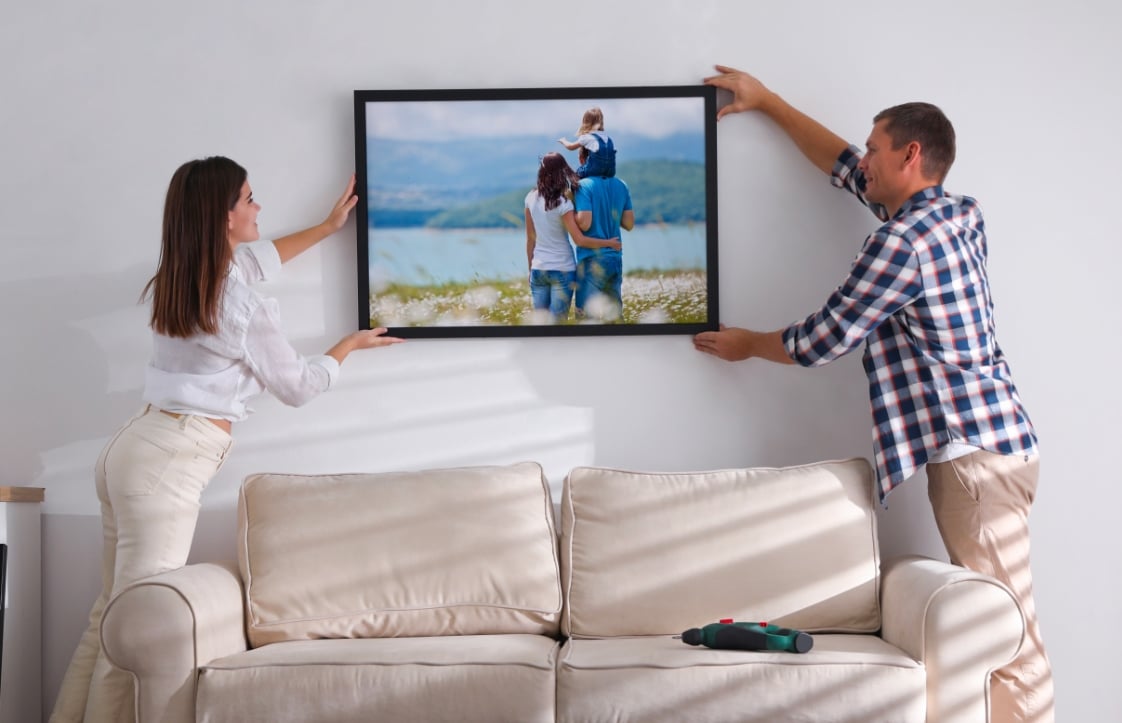Hanging paintings on your walls to decorate your home is easy, if you know how. Read on for practical advice on hanging paintings without a hitch.
How to hang paintings: where to start
So, you want to hang paintings on the walls to beautify and brighten up your home, but without doing irreparable damage. Paintings fitting the style of your house placed in the right spot can definitely change the look of a room, giving it your own personal touch.
Hanging paintings on the walls of a bare room can radically transform it with results you never thought possible. If you’re wondering how difficult it is to hang paintings on walls flawlessly, we have good news: it’s quite easy if you follow our advice.

First things first: you have to pay attention to two aspects in particular:
- The height of the paintings from the floor
- If you’re hanging more than one painting, how they visually interact
If you carefully consider these two aspects, rest assured you won’t make serious mistakes when hanging paintings on walls. However, before getting out the hammer and nails, you need to see to a number of small but important details to be sure your paintings are positioned in the right place.

Before beginning: what you need to hand
Before you start, let’s run through what you need to successfully hang paintings on your walls. There are a few essential tools you need to create a mock-up of what you have in mind before physically hanging the paintings.

We suggest you get:
- A pencil
- An A4 sheet of paper (to draw the layout of the paintings)
- Cardboard (to cut templates the size of the paintings)
- A tape measure (to take accurate measurements)
- Sticky tape (to do some testing by hanging cardboard templates on the wall)
- A spirit level (to check that the holes are aligned on your wall)
But the most important thing you need is your imagination and your powers of observation. They’ll be essential for getting the layout of the paintings right.

How to hang paintings: envision the painting on the wall before you hang it
As you might have guessed, it’s wise to first envision your wall as if the paintings were there. In other words, it’s like seeing a print preview on a photo editor. This way, you can see if your idea fits the style of the room, and avoid drilling pointless holes and damaging your wall for nothing.

To envision the effect of the paintings on your wall, proceed as follows:
1. Draw the wall and the paintings you want to hang
Get a pencil and paper and draw the wall in front of you on a sheet of paper, then sketch the shapes of the painting you want to hang and start evaluating the final result. The details and colours of the paintings don’t matter at this stage: focus on the shapes and how they interact with the surrounding objects: furniture, plants, lamps and accessories. Draw these elements too to give yourself a more precise idea of the final result. You may discover that the room is already too cluttered or still too empty; you might even find a new layout for the furniture to really showcase the paintings.
2.Use the cardboard as a “stunt double” of the paintings you want to hang
Another effective trick is to measure the painting you want to hang and create an outline from cardboard, then hang this on the wall with sticky tape and see how it looks. This cardboard cut-out, the size of the painting you want to hang, is very useful for working out whether the height, position and centring are correct. In other words, it’s a useful test to see if hanging that particular painting on that particular wall is a good idea.

How to hang paintings: useful templates
Now that you have an idea of how your painting will look on your wall, let’s check out some popular layout templates. There are countless layout templates that can be used to hang paintings in a harmonious pattern. All these templates are based on the symmetry or the asymmetry of the shapes of the paintings hung on the walls. You can pick one of these layout templates based on the number and size of the paintings you’re going to hang. You don’t need to follow them strictly – you can just use them as inspiration.

These are just some of the layouts frequently used to hang paintings in places such as art galleries. These templates are tried and tested, and guarantee harmony and aesthetic effect. But remember that the subjects of the paintings should go together nicely too, so experiment based on your own taste and imagination.
How to hang paintings: watch the height!
Besides the layout, there’s another aspect you may want to consider when hanging a painting on a wall: the height of the paintings from the floor. They shouldn’t be placed too high or too low, but at the right height: one that allows the human eye to admire them without tilting the head up or down.
A good rule of thumb is to place the painting at least 120 cm from the floor if you want to hang them on a wall, while if you’re hanging them above a sofa, a height of 100 cm from the floor will do. Don’t forget to carry out the tests we suggested earlier because every room has its own unique features. Use our advice to give yourself an idea of how they will look in the position you are thinking of hanging them.
How to hang paintings: step by step
Once you’ve done all the tests and chosen the position of the paintings on the wall, their height and their layout (if you intend to hang more than one), it’s time to hang them!

Of course, every painting needs a hole in the wall where you’ll place one or more nails to support its weight. For lighter canvases, you can just use a hammer and nails, while for the heavier ones you’ll need a drill, screws and wall plugs strong enough to support the additional weight. Later in the article, we’ll also suggest alternative solutions that don’t involve making holes in the wall, but first we’ll give you the most common solutions for hanging a painting perfectly.

We suggest you ask someone to help you: it’ll be quicker and easier that way.
Let’s look at all the steps you have to follow before making a hole in the wall.
1.Do the final test with cardboard
Cut the cardboard to the size and shape of the actual painting and hang it on the wall with the sticky tape in the very spot you wish to admire it. If you want to hang more than one painting, do the same thing for each picture. You can also use newspaper cut-outs, but make sure that the size is accurate. Next, stand back from the wall and check that the layout is balanced and harmonious. If you want to be completely sure, ask your helper to place the real painting over the template and hold it in place so you can evaluate the actual final result.
2.Draw the edges and mark the point to perforate
Now that you have found the perfect position for your paintings, you’re ready to mark the spots where you’ll make holes in the wall and insert the screws or the nails that will support the painting. This requires precision and it’s better if you do it with a helper. While one holds the painting in place, the other marks the spots where the frame’s hooks are on the wall. The frame must not move and the spots must be marked as accurately as possible, especially if you have more than one hook or the painting is big.
3. Make sure the holes are aligned
Once you have marked the spots for the holes, you need to check they’re perfectly aligned. Otherwise, the painting will look crooked once hung on the wall. To check if the holes are aligned, you need to use a spirit level. It will tell you if the spots you marked for the holes are in a straight line. If they aren’t, rub them out and mark them again, using the spirit level to check their alignment.
4.Make holes in the wall
OK, now you’re ready to make holes in the wall. If the painting is relatively small, a hammer and nails will do. Hammer in the nail with its head pointing slightly upwards at an angle of about 45° to the wall. If you need a drill because the painting is big, drill the holes right where you marked them, then insert the wall plugs and the screws, making sure they’re perfectly straight.

5. Hang your painting and admire it!
If you followed our instructions correctly, all that’s left to do now is hang your painting on the wall. That’s it! Now you can finally admire the painting in all its glory!
If you don’t want to make holes in the wall…
What if you don’t want to make holes in the wall?
You may be renting a home that’s not yours or you may not be confident with tools like drills and hammers. No problem! We have the alternative solutions you’re looking for. For example, you can use super strong adhesive strips that you can stick to the wall and that are designed to support heavy paintings. Some frames have adhesive hooks for sticking to walls. The most advanced solution is picture hanging rails complete with pads and cables, similar to those used in museums. These are especially recommended if your paintings are valuable.
Now you have all the know-how you need, it’s time to grab your tools and start hanging your pictures!
Have fun!

